Let’s consider a vector v whose initial point is the origin in an xy – coordinate system and whose terminal point is . We say that the vector is in standard position
and refer to it as a position vector. Note that the ordered pair
defines the vector uniquely. Thus we can use to denote the vector. To
emphasize that we are thinking of a vector and to avoid the confusion of
notation with ordered – pair and interval notation, we generally write
v = < a, b >.

The coordinate a is the scalar horizontal component of the vector, and the coordinate b is the scalar vertical component of the vector. By scalar, we mean a numerical quantity rather than a vector quantity. Thus, is considered to be the component form of v. Note that a and b are NOT vectors and should not be confused with the vector component definition.
Now consider with A = (x1, y1) and C = (x2, y2). Let’s see how to find the position vector equivalent to
with A = (x1, y1) and C = (x2, y2). Let’s see how to find the position vector equivalent to  .
As you can see in the figure below, the initial point A is relocated to
the origin (0, 0). The coordinates of P are found by subtracting the
coordinates of A from the coordinates of C. Thus, P = (x2 – x1, y2 – y1) and the position vector is
.
As you can see in the figure below, the initial point A is relocated to
the origin (0, 0). The coordinates of P are found by subtracting the
coordinates of A from the coordinates of C. Thus, P = (x2 – x1, y2 – y1) and the position vector is  .
.

It can be shown that and
and  have the same magnitude and direction and are therefore equivalent. Thus,
have the same magnitude and direction and are therefore equivalent. Thus,  =
=  = < x2 – x1, y2 – y1 >.
= < x2 – x1, y2 – y1 >.
The component form of with A = (x1, y1) and C = (x2, y2) is
with A = (x1, y1) and C = (x2, y2) is
 = < x2 – x1, y2 – y1 >.
= < x2 – x1, y2 – y1 >.
Example 1 Find the component form of if C = (- 4, – 3) and F = (1, 5).
if C = (- 4, – 3) and F = (1, 5).
Solution We have
 = < 1 – (- 4), 5 – (- 3) > = < 5, 8 >.
= < 1 – (- 4), 5 – (- 3) > = < 5, 8 >.
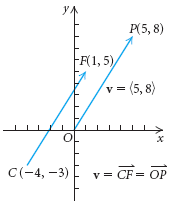
Note that vector is equivalent to position vector
is equivalent to position vector  with as shown in the figure above.
with as shown in the figure above.
Now that we know how to write vectors in component form, let’s restate some definitions.
The length of a vector v is easy to determine when the components of the vector are known. For v = < v1, v2 >, we have
|v|2 = v21 + v22 Using the Pythagorean theorem
|v| = √v21 + v22.

The length, or magnitude, of a vector v = < v1, v2 > is given by |v| = √v21 + v22.
Two vectors are equivalent if they have the same magnitude and the same direction.
Let u = < u1, u2 > and v = < v1, v2 >. Then
< u1, u2 > = < v1, v2 > if and only if u1 = v1 and u2 = v2.

For a real number k and a vector v = < v1, v2 >, the scalar product of k and v is
kv = k.< v1, v2 > = < kv1, kv2 >.
The vector kv is a scalar multiple of the vector v.
Example 2 Let u = < – 5, 4 > and w = < 1, – 1 >.Find – 7w, 3u, and – 1w.
Solution
– 7w = – 7.< 1, – 1 > = < – 7, 7 >,
3u = 3.< – 5, 4 > = < -15, 12 >,
– 1w = – 1.< 1, – 1 > = < – 1, 1 >.
Now we can add two vectors using components. To add two vectors given in component form, we add the corresponding components. Let u = < u1, u2 > and v = < v1, v2 >. Then
u + v = < u = < u1 + v1, u2 + v2 >
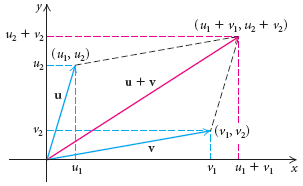
For example, if v = < – 3, 2 > and w = < 5, – 9 >, then
v + w = < – 3 + 5, 2 + (- 9) > = < 2, – 7 >
If u = < u1, u2 > and v = < v1, v2 >, then
u + v = < u1 + v1, u2 + v2 >.
Before we define vector subtraction, we need to define – v. The opposite of v = < v1, v2 >, shown below, is
– v = (- 1).v = (- 1)< v1, v2 > = < – v1, – v2 >
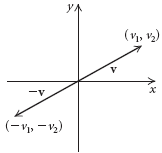
Vector subtraction such as u – v involves subtracting corresponding components. We show this by rewriting u – v as u + (- v). If u = < u1, u2 > and v = < v1, v2 >, then
u – v = u + (- v) = < u1, u2 > + < – v1, – v2 > = < u1 + (- v1), u2 + (- v2) > = < u1 – v1, u2 – v2 >
We can illustrate vector subtraction with parallelograms, just as we did vector addition.

u – v = < u1 – v1, u2 – v2 >.
It is interesting to compare the sum of two vectors with the difference of the same two vectors in the same parallelogram. The vectors u + v and u – v are the diagonals of the parallelogram.
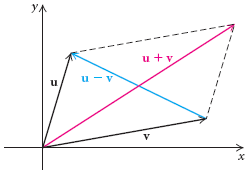
Example 3 Do the following calculations, where u = < 7, 2 > and v = < – 3, 5 >.
a) u + v
b) u – 6v
c)3u + 4v
d)|5v – 2u|
Solution
a) u + v = < 7, 2 > + < – 3, 5 > = < 7 + (- 3), 2 + 5 > = < 4, 7 >;
b)u – 6v = < 7, 2 > – 6.< – 3, 5 > = < 7, 2 > – < – 18, 30 > = < 25, – 28 >;
c) 3u + 4v = 3.< 7, 2> + 4.< – 3, 5 > = < 21, 6 > + < – 12, 20 > = < 9, 26 >;
d) |5v – 2u| = |5.< – 3, 5 > – 2.< 7, 2 >| = |< – 15, 25 > – < 14, 4 >| = |< – 29, 21 >| = √(- 29)2 + 212 = √1282 ≈ 35,8
Before we state the properties of vector addition and scalar multiplication, we need to define another special vector—the zero vector. The vector whose initial and terminal points are both is the zero vector, denoted by O, or < 0, 0 > . Its magnitude is 0. In vector addition, the zero vector is the additive identity vector:
v + O = v. < v1, v2 > + < 0, 0 > = < v1, v2 >
Operations on vectors share many of the same properties as operations on real numbers.
1. u + v = v + u.
2. u + (v + w) = (u + v) + w.
3. v + O = v.
4 1.v = v; 0.v = O.
5. v + (- v) = O.
6. b(cv) = (bc)v.
7. (b + c)v = bv + cv.
8. b(u + v) = bu + bv.
|v| = |< – 3/5, 4/5 >| = √(- 3/5)2 + (4/5)2 = √9/25 + 16/25 = √25/25 = √1 = 1.
Example 4 Find a unit vector that has the same direction as the vector w = < – 3, 5 >.
Solution We first find the length of w:
|w| = √(- 3)2 + 52 = √34. Thus we want a vector whose length is 1/√34 of w and whose direction is the same as vector w. That vector is
u = w/√34 = < – 3, 5 >/√34 = < – 3/√34, 5/√34 >.
The vector u is a unit vector because
|u| = |w/√34| = = √34/34 = √1 = 1.
= √34/34 = √1 = 1.
If v is a vector and v ≠ O, then
(1/|v|)• v, or v/|v|,
is a unit vector in the direction of v.
Although unit vectors can have any direction, the unit vectors parallel to the x – and y – axes are particularly useful. They are defined as
i = < 1, 0 > and j = < 0, 1 >.
Any vector can be expressed as a linear combination of unit vectors i and j. For example, let v = < v1, v2 >. Then
v = < v1, v2 > = < v1, 0 > + < 0, v2 > = v1< 1, 0 > + v2 < 0, 1 > = v1i + v2j.
Example 5 Express the vector r = < 2, – 6 > as a linear combination of i and j.
Solution
r = < 2, – 6 > = 2i + (- 6)j = 2i – 6j.
Example 6 Write the vector q = – i + 7j in component form.
Solutionq = – i + 7j = -1i + 7j = < – 1, 7 >
Vector operations can also be performed when vectors are written as linear combinations of i and j.
Example 7 If a = 5i – 2j and b = -i + 8j, find 3a – b.
Solution
3a – b = 3(5i – 2j) – (- i + 8j) = 15i – 6j + i – 8j = 16i – 14j.
u = < cosθ, sinθ >,
or as a linear combination of the unit vectors i and j,
u = (cosθ)i + (sinθ)j,
where the components of u are functions of the direction angle θ measured counterclockwise from the x – axis to the vector. As θ varies from 0 to 2π, the point P traces the circle x2 + y2 = 1. This takes in all possible directions for unit vectors so the equation u = (cosθ)i + (sinθ)j describes every possible unit vector in the plane.
Example 8 Calculate and sketch the unit vector u = (cosθ)i + (sinθ)j for θ = 2π/3. Include the unit circle in your sketch.
Solution
u = (cos(2π/3))i + (sin(2π/3))j = (- 1/2)i + (√3/2)j
Let v = < v1, v2 > with direction angle θ. Using the definition of the tangent function, we can determine the direction angle from the components of v:
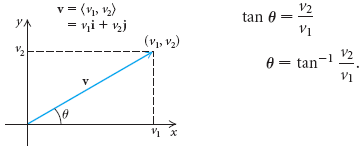
Example 9 Determine the direction angle θ of the vector w = – 4i – 3j.
Solution We know that
w = – 4i – 3j = < – 4, – 3 >.
Thus we have
tanθ = (- 3)/(- 4) = 3/4 and θ = tan– 1(3/4).
Since w is in the third quadrant, we know that θ is a third-quadrant angle. The reference angle is
tan– 1(3/4) ≈ 37°, and θ ≈ 180° + 37°, or 217°.
It is convenient for work with applied problems and in subsequent courses, such as calculus, to have a way to express a vector so that both its magnitude and its direction can be determined, or read, easily. Let v be a vector. Then v/|v| is a unit vector in the same direction as v. Thus we have
v/|v| = (cosθ)i + (sinθ)j
v = |v|[(cosθ)i + (sinθ)j] Multiplying by |v|
v = |v|(cosθ)i + |v|(sinθ)j.
Example 10 Airplane Speed and Direction. An airplane travels on a bearing of 100° at an airspeed of 190 km/h while a wind is blowing 48 km/h from 220°. Find the ground speed of the airplane and the direction of its track, or course, over the ground.
Solution We first make a drawing. The wind is represented by and the velocity vector of the airplane by
and the velocity vector of the airplane by  . The resultant velocity vector is v, the sum of the two vectors:
. The resultant velocity vector is v, the sum of the two vectors:
v = +
+  .
.

The bearing (measured from north) of the airspeed vector is 100°. Its direction angle (measured counterclockwise from the
positive x – axis) is 350°. The bearing (measured from north) of the
wind vector
is 100°. Its direction angle (measured counterclockwise from the
positive x – axis) is 350°. The bearing (measured from north) of the
wind vector  is 220°. Its direction angle (measured counterclockwise from the positive x – axis) is 50°. The magnitudes of
is 220°. Its direction angle (measured counterclockwise from the positive x – axis) is 50°. The magnitudes of  and
and  are 190 and 48, respectively.We have
are 190 and 48, respectively.We have
 = 190(cos350°)i + 190(sin350°)j, and
= 190(cos350°)i + 190(sin350°)j, and
 = 48(cos50°)i + 48(sin50°)j.
= 48(cos50°)i + 48(sin50°)j.
Thus,
v = +
+ 
= [190(cos350°)i + 190(sin350°)j] + [48(cos50°)i + 48(sin50°)j]
= [190(cos350°)i + 48(cos50°)i] + [190(sin350°)j + 48(sin50°)j]
≈ 217,97i + 3,78j.
From this form, we can determine the ground speed and the course:
Ground speed ≈ √(217,97)2 + (3,78)2 ≈ 218 km/h.
We let α be the direction angle of v. Then
tanα = 3,78/217,97
α = tan– 13,78/217,97 ≈ 1°.
Thus the course of the airplane (the direction from north) is 90° – 1°, or 89°.
The dot product of two vectors u = < u1, u2 > and v = < v1, v2 > is
u • v = u1.v1 + u2.v2
(Note that u1v1 + u2v2 is a scalar, not a vector.)
Example 11 Find the indicated dot product when
u = < 2, – 5 >, v = < 0, 4 > and w = < – 3, 1 >.
a)u • w
b)w • v
Solution
a) u • w = 2(- 3) + (- 5)1 = – 6 – 5 = – 11;
b) w • v = (- 3)0 + 1(4) = 0 + 4 = 4.
The dot product can be used to find the angle between two vectors. The angle between two vectors is the smallest positive angle formed by the two directed line segments. Thus the angle θ between u and v is the same angle as between v and u,and 0 ≤ θ ≤ π.
If θ is the angle between two nonzero vectors u and v, then
cosθ = (u • v)/|u||v|.
Example 12 Find the angle between u = < 3, 7 > and v = < – 4, 2 >.
Solution We begin by finding u • v, |u|, and |v|:
u • v = 3(- 4) + 7(2) = 2,
|u| = √32 + 72 = √58, and
|v| = √(- 4)2 + 22 = √20.
Then
cosα = (u • v)/|u||v| = 2/√58.√20
α = cos– 1(2/√58.√20)
α ≈ 86,6°.
Example 13 Suspended Block. A 350-lb block is suspended by two cables, as shown at left. At point A, there are three forces acting: W, the block pulling down, and R and S, the two cables pulling upward and outward. Find the tension in each cable.
Solution We draw a force diagram with the initial points of each vector at the origin. For there to be a balance, the vector sum must be the vector O:
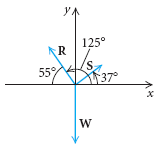
R + S + W = O.
We can express each vector in terms of its magnitude and its direction angle:
R = |R|[(cos125°)i + (sin125°)j],
S = |S|[(cos37°)i + (sin37°)j], and
W = |W|[(cos270°)i + (sin270°)j]
= 350(cos270°)i + 350(sin270°)j
= -350j cos270° = 0; sin270° = – 1.
Substituting for R, S, and W in R + S + W + O, we have
[|R|(cos125°) + |S|(cos37°)]i + [|R|(sin125°) + |S|(sin37°) – 350]j = 0i + 0j.
This gives us a system of equations:
|R|(cos125°) + |S|(cos37°) = 0,
|R|(sin125°) + |S|(sin37°) – 350 = 0.
Solving this system, we get
|R| ≈ 280 and |S| ≈ 201.
The tensions in the cables are 280 lb and 201 lb.
v = < a, b >.

The coordinate a is the scalar horizontal component of the vector, and the coordinate b is the scalar vertical component of the vector. By scalar, we mean a numerical quantity rather than a vector quantity. Thus, is considered to be the component form of v. Note that a and b are NOT vectors and should not be confused with the vector component definition.
Now consider
 with A = (x1, y1) and C = (x2, y2). Let’s see how to find the position vector equivalent to
with A = (x1, y1) and C = (x2, y2). Let’s see how to find the position vector equivalent to  .
As you can see in the figure below, the initial point A is relocated to
the origin (0, 0). The coordinates of P are found by subtracting the
coordinates of A from the coordinates of C. Thus, P = (x2 – x1, y2 – y1) and the position vector is
.
As you can see in the figure below, the initial point A is relocated to
the origin (0, 0). The coordinates of P are found by subtracting the
coordinates of A from the coordinates of C. Thus, P = (x2 – x1, y2 – y1) and the position vector is  .
.
It can be shown that
 and
and  have the same magnitude and direction and are therefore equivalent. Thus,
have the same magnitude and direction and are therefore equivalent. Thus,  =
=  = < x2 – x1, y2 – y1 >.
= < x2 – x1, y2 – y1 >.The component form of
 with A = (x1, y1) and C = (x2, y2) is
with A = (x1, y1) and C = (x2, y2) is = < x2 – x1, y2 – y1 >.
= < x2 – x1, y2 – y1 >.Example 1 Find the component form of
 if C = (- 4, – 3) and F = (1, 5).
if C = (- 4, – 3) and F = (1, 5).Solution We have
 = < 1 – (- 4), 5 – (- 3) > = < 5, 8 >.
= < 1 – (- 4), 5 – (- 3) > = < 5, 8 >.
Note that vector
 is equivalent to position vector
is equivalent to position vector  with as shown in the figure above.
with as shown in the figure above.Now that we know how to write vectors in component form, let’s restate some definitions.
The length of a vector v is easy to determine when the components of the vector are known. For v = < v1, v2 >, we have
|v|2 = v21 + v22 Using the Pythagorean theorem
|v| = √v21 + v22.

The length, or magnitude, of a vector v = < v1, v2 > is given by |v| = √v21 + v22.
Two vectors are equivalent if they have the same magnitude and the same direction.
Let u = < u1, u2 > and v = < v1, v2 >. Then
< u1, u2 > = < v1, v2 > if and only if u1 = v1 and u2 = v2.
Operations on Vectors
To multiply a vector v by a positive real number, we multiply its length by the number. Its direction stays the same. When a vector v is multiplied by 2 for instance, its length is doubled and its direction is not changed. When a vector is multiplied by 1.6, its length is increased by 60% and its direction stays the same. To multiply a vector v by a negative real number, we multiply its length by the number and reverse its direction. When a vector is multiplied by 2, its length is doubled and its direction is reversed. Since real numbers work like scaling factors in vector multiplication, we call them scalars and the products kv are called scalar multiples of v.
For a real number k and a vector v = < v1, v2 >, the scalar product of k and v is
kv = k.< v1, v2 > = < kv1, kv2 >.
The vector kv is a scalar multiple of the vector v.
Example 2 Let u = < – 5, 4 > and w = < 1, – 1 >.Find – 7w, 3u, and – 1w.
Solution
– 7w = – 7.< 1, – 1 > = < – 7, 7 >,
3u = 3.< – 5, 4 > = < -15, 12 >,
– 1w = – 1.< 1, – 1 > = < – 1, 1 >.
Now we can add two vectors using components. To add two vectors given in component form, we add the corresponding components. Let u = < u1, u2 > and v = < v1, v2 >. Then
u + v = < u = < u1 + v1, u2 + v2 >

For example, if v = < – 3, 2 > and w = < 5, – 9 >, then
v + w = < – 3 + 5, 2 + (- 9) > = < 2, – 7 >
If u = < u1, u2 > and v = < v1, v2 >, then
u + v = < u1 + v1, u2 + v2 >.
Before we define vector subtraction, we need to define – v. The opposite of v = < v1, v2 >, shown below, is
– v = (- 1).v = (- 1)< v1, v2 > = < – v1, – v2 >

Vector subtraction such as u – v involves subtracting corresponding components. We show this by rewriting u – v as u + (- v). If u = < u1, u2 > and v = < v1, v2 >, then
u – v = u + (- v) = < u1, u2 > + < – v1, – v2 > = < u1 + (- v1), u2 + (- v2) > = < u1 – v1, u2 – v2 >
We can illustrate vector subtraction with parallelograms, just as we did vector addition.

Vector Subtraction
If u = < u1, u2 > and v = < v1, v2 >, thenu – v = < u1 – v1, u2 – v2 >.
It is interesting to compare the sum of two vectors with the difference of the same two vectors in the same parallelogram. The vectors u + v and u – v are the diagonals of the parallelogram.

Example 3 Do the following calculations, where u = < 7, 2 > and v = < – 3, 5 >.
a) u + v
b) u – 6v
c)3u + 4v
d)|5v – 2u|
Solution
a) u + v = < 7, 2 > + < – 3, 5 > = < 7 + (- 3), 2 + 5 > = < 4, 7 >;
b)u – 6v = < 7, 2 > – 6.< – 3, 5 > = < 7, 2 > – < – 18, 30 > = < 25, – 28 >;
c) 3u + 4v = 3.< 7, 2> + 4.< – 3, 5 > = < 21, 6 > + < – 12, 20 > = < 9, 26 >;
d) |5v – 2u| = |5.< – 3, 5 > – 2.< 7, 2 >| = |< – 15, 25 > – < 14, 4 >| = |< – 29, 21 >| = √(- 29)2 + 212 = √1282 ≈ 35,8
Before we state the properties of vector addition and scalar multiplication, we need to define another special vector—the zero vector. The vector whose initial and terminal points are both is the zero vector, denoted by O, or < 0, 0 > . Its magnitude is 0. In vector addition, the zero vector is the additive identity vector:
v + O = v. < v1, v2 > + < 0, 0 > = < v1, v2 >
Operations on vectors share many of the same properties as operations on real numbers.
Properties of Vector Addition and Scalar Multiplication
For all vectors u, v, and w, and for all scalars b and c:1. u + v = v + u.
2. u + (v + w) = (u + v) + w.
3. v + O = v.
4 1.v = v; 0.v = O.
5. v + (- v) = O.
6. b(cv) = (bc)v.
7. (b + c)v = bv + cv.
8. b(u + v) = bu + bv.
Unit Vectors
A vector of magnitude, or length, 1 is called a unit vector. The vector v = < – 3/5, 4/5 > is a unit vector because|v| = |< – 3/5, 4/5 >| = √(- 3/5)2 + (4/5)2 = √9/25 + 16/25 = √25/25 = √1 = 1.
Example 4 Find a unit vector that has the same direction as the vector w = < – 3, 5 >.
Solution We first find the length of w:
|w| = √(- 3)2 + 52 = √34. Thus we want a vector whose length is 1/√34 of w and whose direction is the same as vector w. That vector is
u = w/√34 = < – 3, 5 >/√34 = < – 3/√34, 5/√34 >.
The vector u is a unit vector because
|u| = |w/√34| =
 = √34/34 = √1 = 1.
= √34/34 = √1 = 1.If v is a vector and v ≠ O, then
(1/|v|)• v, or v/|v|,
is a unit vector in the direction of v.
Although unit vectors can have any direction, the unit vectors parallel to the x – and y – axes are particularly useful. They are defined as
i = < 1, 0 > and j = < 0, 1 >.
Any vector can be expressed as a linear combination of unit vectors i and j. For example, let v = < v1, v2 >. Then
v = < v1, v2 > = < v1, 0 > + < 0, v2 > = v1< 1, 0 > + v2 < 0, 1 > = v1i + v2j.
Example 5 Express the vector r = < 2, – 6 > as a linear combination of i and j.
Solution
r = < 2, – 6 > = 2i + (- 6)j = 2i – 6j.
Example 6 Write the vector q = – i + 7j in component form.
Solutionq = – i + 7j = -1i + 7j = < – 1, 7 >
Vector operations can also be performed when vectors are written as linear combinations of i and j.
Example 7 If a = 5i – 2j and b = -i + 8j, find 3a – b.
Solution
3a – b = 3(5i – 2j) – (- i + 8j) = 15i – 6j + i – 8j = 16i – 14j.
Direction Angles
The terminal point P of a unit vector in standard position is a point on the unit circle denoted by (cosθ, sinθ). Thus the unit vector can be expressed in component form,u = < cosθ, sinθ >,
or as a linear combination of the unit vectors i and j,
u = (cosθ)i + (sinθ)j,
where the components of u are functions of the direction angle θ measured counterclockwise from the x – axis to the vector. As θ varies from 0 to 2π, the point P traces the circle x2 + y2 = 1. This takes in all possible directions for unit vectors so the equation u = (cosθ)i + (sinθ)j describes every possible unit vector in the plane.
Example 8 Calculate and sketch the unit vector u = (cosθ)i + (sinθ)j for θ = 2π/3. Include the unit circle in your sketch.
Solution
u = (cos(2π/3))i + (sin(2π/3))j = (- 1/2)i + (√3/2)j
Let v = < v1, v2 > with direction angle θ. Using the definition of the tangent function, we can determine the direction angle from the components of v:

Example 9 Determine the direction angle θ of the vector w = – 4i – 3j.
Solution We know that
w = – 4i – 3j = < – 4, – 3 >.
Thus we have
tanθ = (- 3)/(- 4) = 3/4 and θ = tan– 1(3/4).
Since w is in the third quadrant, we know that θ is a third-quadrant angle. The reference angle is
tan– 1(3/4) ≈ 37°, and θ ≈ 180° + 37°, or 217°.
It is convenient for work with applied problems and in subsequent courses, such as calculus, to have a way to express a vector so that both its magnitude and its direction can be determined, or read, easily. Let v be a vector. Then v/|v| is a unit vector in the same direction as v. Thus we have
v/|v| = (cosθ)i + (sinθ)j
v = |v|[(cosθ)i + (sinθ)j] Multiplying by |v|
v = |v|(cosθ)i + |v|(sinθ)j.
Example 10 Airplane Speed and Direction. An airplane travels on a bearing of 100° at an airspeed of 190 km/h while a wind is blowing 48 km/h from 220°. Find the ground speed of the airplane and the direction of its track, or course, over the ground.
Solution We first make a drawing. The wind is represented by
 and the velocity vector of the airplane by
and the velocity vector of the airplane by  . The resultant velocity vector is v, the sum of the two vectors:
. The resultant velocity vector is v, the sum of the two vectors:v =
 +
+  .
.
The bearing (measured from north) of the airspeed vector
 is 100°. Its direction angle (measured counterclockwise from the
positive x – axis) is 350°. The bearing (measured from north) of the
wind vector
is 100°. Its direction angle (measured counterclockwise from the
positive x – axis) is 350°. The bearing (measured from north) of the
wind vector  is 220°. Its direction angle (measured counterclockwise from the positive x – axis) is 50°. The magnitudes of
is 220°. Its direction angle (measured counterclockwise from the positive x – axis) is 50°. The magnitudes of  and
and  are 190 and 48, respectively.We have
are 190 and 48, respectively.We have = 190(cos350°)i + 190(sin350°)j, and
= 190(cos350°)i + 190(sin350°)j, and = 48(cos50°)i + 48(sin50°)j.
= 48(cos50°)i + 48(sin50°)j.Thus,
v =
 +
+ 
= [190(cos350°)i + 190(sin350°)j] + [48(cos50°)i + 48(sin50°)j]
= [190(cos350°)i + 48(cos50°)i] + [190(sin350°)j + 48(sin50°)j]
≈ 217,97i + 3,78j.
From this form, we can determine the ground speed and the course:
Ground speed ≈ √(217,97)2 + (3,78)2 ≈ 218 km/h.
We let α be the direction angle of v. Then
tanα = 3,78/217,97
α = tan– 13,78/217,97 ≈ 1°.
Thus the course of the airplane (the direction from north) is 90° – 1°, or 89°.
Angle Between Vectors
When a vector is multiplied by a scalar, the result is a vector. When two vectors are added, the result is also a vector. Thus we might expect the product of two vectors to be a vector as well, but it is not. The dot product of two vectors is a real number, or scalar. This product is useful in finding the angle between two vectors and in determining whether two vectors are perpendicular.The dot product of two vectors u = < u1, u2 > and v = < v1, v2 > is
u • v = u1.v1 + u2.v2
(Note that u1v1 + u2v2 is a scalar, not a vector.)
Example 11 Find the indicated dot product when
u = < 2, – 5 >, v = < 0, 4 > and w = < – 3, 1 >.
a)u • w
b)w • v
Solution
a) u • w = 2(- 3) + (- 5)1 = – 6 – 5 = – 11;
b) w • v = (- 3)0 + 1(4) = 0 + 4 = 4.
The dot product can be used to find the angle between two vectors. The angle between two vectors is the smallest positive angle formed by the two directed line segments. Thus the angle θ between u and v is the same angle as between v and u,and 0 ≤ θ ≤ π.
If θ is the angle between two nonzero vectors u and v, then
cosθ = (u • v)/|u||v|.
Example 12 Find the angle between u = < 3, 7 > and v = < – 4, 2 >.
Solution We begin by finding u • v, |u|, and |v|:
u • v = 3(- 4) + 7(2) = 2,
|u| = √32 + 72 = √58, and
|v| = √(- 4)2 + 22 = √20.
Then
cosα = (u • v)/|u||v| = 2/√58.√20
α = cos– 1(2/√58.√20)
α ≈ 86,6°.
Forces in Equilibrium
When several forces act through the same point on an object, their vector sum must be O in order for a balance to occur. When a balance occurs, then the object is either stationary or moving in a straight line without acceleration. The fact that the vector sum must be O for a balance, and vice versa, allows us to solve many applied problems involving forces.Example 13 Suspended Block. A 350-lb block is suspended by two cables, as shown at left. At point A, there are three forces acting: W, the block pulling down, and R and S, the two cables pulling upward and outward. Find the tension in each cable.
Solution We draw a force diagram with the initial points of each vector at the origin. For there to be a balance, the vector sum must be the vector O:

R + S + W = O.
We can express each vector in terms of its magnitude and its direction angle:
R = |R|[(cos125°)i + (sin125°)j],
S = |S|[(cos37°)i + (sin37°)j], and
W = |W|[(cos270°)i + (sin270°)j]
= 350(cos270°)i + 350(sin270°)j
= -350j cos270° = 0; sin270° = – 1.
Substituting for R, S, and W in R + S + W + O, we have
[|R|(cos125°) + |S|(cos37°)]i + [|R|(sin125°) + |S|(sin37°) – 350]j = 0i + 0j.
This gives us a system of equations:
|R|(cos125°) + |S|(cos37°) = 0,
|R|(sin125°) + |S|(sin37°) – 350 = 0.
Solving this system, we get
|R| ≈ 280 and |S| ≈ 201.
The tensions in the cables are 280 lb and 201 lb.

No comments:
Post a Comment